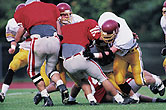
WEDNESDAY, Nov. 11 (HealthDay News) — When it comes to teaching healthy behaviors, boys’ high school team sports might be doing more harm than thought.
New research suggests that for teenage boys, participation in team sports may encourage unruly behavior such as fighting and binge drinking.
Girls, on the other hand, seem to behave better in organized sports, said the lead researcher, Susan Connor, manager of the injury prevention program at Rainbow Babies & Children’s Hospital in Cleveland.
“The research raises more questions than it answers,” said Connor, who was to present her findings at the American Public Health Association’s annual meeting, in Philadelphia, which concludes Wednesday. “We were looking at a broad database, so we do not know why team sports may affect boys differently or how they affect them. That’s a topic for further research.”
Connor and her team studied the responses of more than 13,000 U.S. high school students who took part in the 2007 Youth Risk Behavioral Study, an assessment of adolescent high-risk behaviors conducted by the federal Centers for Disease Control and Prevention.
According to Connor’s findings, roughly 60 percent of the male respondents said they had played in at least one team sport in the past year. For girls, the participation rate was 48 percent.
The data did not specify which sports the teenagers participated in, although the top high school sports in the 2000 U.S. Census included basketball, football, baseball, soccer, track and field, and cross-country running.
For boys, the study found that participation in team sports correlated with an increased likelihood of fighting, drinking and binge drinking. Rates of depression and smoking, however, seemed to decline.
The findings were different for girls. White girls who were active in team sports reported lower levels of fighting, depression, smoking, marijuana use and unhealthy weight-loss practices, Connor and her colleagues found. Black high school girls reported increased levels of binge drinking.
“I think the issue is more socio-economic than race,” said Connor, who added that more research is needed to explore the slight behavior differences between black and white female high school athletes.
Connor stopped short of offering explanations for the apparent negative aspects of boys’ team sports. One possibility, she said, is that there is a culture in male sports that creates a climate of poor behavior.
“There are certainly health benefits in playing team sports,” said Connor. “But there is also this misconception, which is very widespread, that sports are all good. As a parent, you can’t assume your kid is protected. Sports are what you and your child make of it.”
Robert Regal, a psychologist in private practice in Valhalla, N.Y., agreed with Connor’s findings. Part of the problem, he said, is that boys’ teams may inherently attract athletes who are aggressive and highly competitive, leading to unruly behavior once they join a team.
“There are pre-existing expectations for both male and female athletes,” he said. “To be a female athlete means not having the same kind of hyper-aggressive, big-man-on-campus image. For guys, team sports are played with a great deal of expectation for success. It’s written into the team ethic.
“I’d be curious to see the behaviors of the top girls’ teams, the ones that win the state championships. I suspect they mirror the behaviors of the boys,” Regal added.
More information
The American Psychological Association has more on the benefits of regular exercise.

